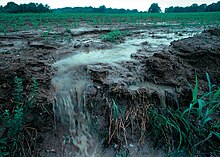Soil horizon
No one system is more correct—as artificial constructs, their utility lies in their ability to accurately describe local conditions in a consistent manner.Soils with a history of human interference, for instance through major earthworks or regular deep ploughing, may lack distinct horizons almost completely.When examining soils in the field, attention must be paid to the local geomorphology and the historical uses to which the land has been put, in order to ensure that the appropriate names are applied to the observed horizons.But in some soils, clay minerals, iron, aluminum, organic compounds, and other constituents are soluble and move downwards.The A horizon may also be the result of a combination of soil bioturbation and surface processes that winnow fine particles from biologically mounded topsoil.B) Subsoil: This layer normally has less organic matter than the A horizon, so its colour is mainly derived from iron oxides.The process of accumulation of clay minerals, iron, aluminum, and organic compounds, is referred to as illuviation.Unlike the above layers, R horizons consist largely of continuous masses (as opposed to boulders) of hard rock that cannot be excavated by hand.The designations are found in Chapter 10 of the World Reference Base for Soil Resources Manual, 4th edition (2022).[2] The chapter starts with some general definitions: The fine earth comprises the soil constituents ≤ 2 mm.The whole soil comprises fine earth, coarse fragments, artefacts, cemented parts, and dead plant residues of any size.Examples: AhBw, BwAh, AhE, EAh, EBg, BgE, BwC, CBw, BsC, CBs.However, the symbol E may be used without regard to the position in the profile for any horizon that meets the requirements and that has resulted from soil genesis.Included as C layers are sediments, saprolite, non-indurated bedrock, and other geological materials that commonly slake within 24 hours when air-dry or drier chunks are placed in water, and that, when moist, can be dug with a spade.Granite, basalt, quartzite, and indurated limestone or sandstone are examples of bedrock that are designated R. Air-dry or drier chunks of an R layer, when placed in water, will not slake within 24 hours.The R layer is sufficiently coherent when moist to make hand digging with a spade impractical.It is a surface layer, dominated by the presence of large amounts of organic matter in varying stages of decomposition.In the Australian system, the O horizon should be considered distinct from the layer of leaf litter covering many heavily vegetated areas, which contains no weathered mineral particles and is not part of the soil itself.The technical definition of an A horizon may vary between the systems, but it is most commonly described in terms relative to deeper layers."A" horizons may be darker in colour than deeper layers and contain more organic matter, or they may be lighter but contain less clay or pedogenic oxides.Soil organisms such as earthworms, potworms (enchytraeids), arthropods, nematodes, fungi, and many species of bacteria and archaea are concentrated here, often in close association with plant roots.In soils that contain gravels, due to animal bioturbation, a stonelayer commonly forms near or at the base of the E horizon.It is usually brownish or reddish due to the iron oxides, which increases the chroma of the subsoil to a degree that it can be distinguished from the other horizons.The A/E/B horizons are referred to collectively as the "solum", the surface depth of the soil where biologically activity and climate effects drives pedogenesis.The layers below the solum have no collective name but are distinct in that they are noticeably less affected by surface soil-forming processes.Unlike the above layers, R horizons largely comprise continuous masses (as opposed to boulders) of hard rock that cannot be excavated by hand.Firstly, each major horizon may be divided into sub-horizons by the addition of a numerical subscript, based on minor shifts in colour or texture with increasing depth (e.g., B21, B22, B23 etc.).While this can add necessary depth to a field description, workers should bear in mind that excessive division of a soil profile into narrow sub-horizons should be avoided.Walking as little as ten metres in any direction and digging another hole can often reveal a very different profile in regards to the depth and thickness of each horizon.Based on the identified diagnostic horizons, one can proceed with the allocation of the soil to a taxonomic unit.





soil classificationWorld Reference Base for Soil ResourcesUSDA soil taxonomyAustralian Soil ClassificationpedogenesisgeomorphologyOrganic surface layerPlant litterSurface soilorganic mattersoil lifeweatheringoxidesaluminumeluviationbioturbationtopsoilSubsoililluviationBedrockSphagnumdrainedsoil formationstructuresilicacarbonatesgypsumConcretionsnodulesSaprolitejarositesodiumreductionSlickensidesartefactsPlinthitesoil structureallophanesimogolitesFragiccryogenic alterationBulk densityvolcanic glasseshumifiedaluminiumchromailluvialbrittlenesspedogenic processesdiatomsDiatomaceousFragipancryoturbationanhydritepermafrostsulfidesartifactsleaf litterSurface runoffnonpoint source pollutionbiological activityearthwormspotwormsarthropodsnematodesbacteriaarchaeaplant rootsbiomantleEluviumLuvisolsilicatesgravelsstonelayerParent materialleachingCaithnessLimnicgleyedsesquioxidePaleosolsoil typesPetrocalcic horizonUmbric horizonMollisolsCambic horizonDuripanArchaeological horizonpublic domain materialUnited States GovernmentWayback MachineSoil scienceHistoryPedologyEdaphologySoil biologySoil microbiologySoil zoologySoil ecologySoil physicsSoil mechanicsSoil chemistryEnvironmental soil scienceAgricultural soil sciencePedosphereSoil morphologyPedodiversitySoil erosionSoil contaminationSoil retrogression and degradationSoil compactionSoil compaction (agriculture)Soil sealingSoil salinityAlkali soilSoil pHSoil acidificationSoil healthSoil biodiversitySoil qualitySoil valueSoil fertilitySoil resilienceSoil colorSoil texturePore space in soil